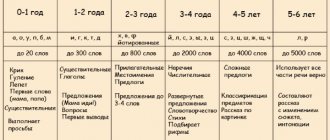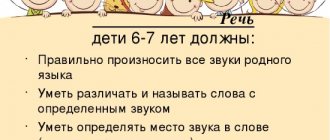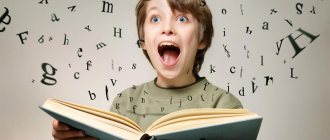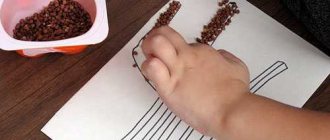- home
- Speech development
The formation and active development of the level of coherent speech for preschoolers requires not only the increased attention of both parents, but also specialized classes that can be conducted in a playful or theatrical form, which is especially attractive to children. In the process of working with children, speech therapists and teachers use many modern techniques, among which mnemonics stands out, aimed at actively developing the level of coherent speech and memory in preschool children.
What is mnemonics
Mnemonics for increasing the level of speech development is a set of techniques aimed at improving perception with memorization of various information using sound samples and visual illustrations.
Provided that classes are carried out systematically, mnemonics for speech development allow you to:
- improve the memorization of heard texts in the form of stories, fairy tales, etc.;
- transform visually acquired data into abstract (and vice versa);
- create logical chains of events;
- Expand words knowledge;
- stimulate the development of imagination and thinking;
- develop children’s ability to compose complex sentences of a descriptive type, which include many words.
Mnemonics, as one of the most effective methods of memorization, is actively used not only by speech therapists, but also by teachers in kindergartens and other preschool institutions.
There are no age restrictions for classes, but many specialized experts recognize the age of 4-5 years as the most optimal, when children already have a fairly rich and varied stock of words and phrases that they can actively use.
The main tool that is used in mnemonics for developing the level of coherent speech in preschool children are mnemonic tables - specific diagrams in which certain information data is embedded.
Mnemonic diagrams for the little ones should be painted in bright shades so that the image that a frog is green, a chicken is yellow, etc. is imprinted in their minds.
For older children, it is preferable to use single-color schemes that do not distract attention, distracting them with additional, and often unnecessary, details.
Learning results through mnemonic tables
In the vast majority of cases, learning and speech development through mnemonic tables in preschool children is successful. Children significantly expand their horizons and knowledge about the world around them, their imagination noticeably develops, they begin to actively come up with their own plots and entertaining stories.
The children develop an increased interest in various poems and obtain new information about the world around them, their vocabulary expands, and they become ready to speak in front of audiences.
Mnemonics of coherent speech for preschoolers is a popular and widespread technique, the action of which is aimed at improving the procedure for memorizing material, developing associative thinking and beautiful, competent coherent speech.
Areas of use of mnemonic tables
Mnemonic tables for the formation and development of coherent speech (developmental and educational) are images of textual information that is previously divided into groups of words in sequential order. There is one illustration for each group of words. Thanks to such a schematic sketch of information, the baby easily perceives it, remembering everything without much effort.
Using mnemonic tables for speech development, the following is carried out:
- Memorizing fairy tales or rhymes. Young children take part with great interest in educational games based on fairy tales they know. At home, you can invite your child to tell a story to his favorite toy, using a series of pictures. You can also draw a mnemonic table together, depicting the heroes of events with your own invented symbols, for example, a triangle is a person, a wavy line is a cloud in the sky. Thus, not only the formation of coherent speech occurs, but also the active development of imagination and fantasy with the manifestation of the hidden creative abilities of children.
- Learning general rules, such as how to brush your teeth correctly. The diagrams depict the sequence of all manipulations that are easily perceived and remembered.
- Compiling stories describing objects, events, pets, etc. Focusing on pictures that answer basic questions: who is it, what color is it, what sounds does it make, what does it like to eat, etc., children can create a consistent description.
- Working on a retelling. After reading the text, the most difficult words are highlighted, the meaning of which must be explained to the child. After the explanations, a conversation should be held on the entire content of the text with a demonstration of drawings from the mnemonic table. A joint retelling using pictures will allow the child to quickly remember information and tell the story he heard himself.
- Solving riddles. With the help of mnemonic tables, children learn to identify an exact object, focusing on its characteristics. At the first stage, it is necessary to explain to the child everything that is depicted in each picture, and only after that offer to independently guess the encrypted object.
Speech therapy classes on the development of coherent speech using a variety of mnemonic diagrams involve memorizing and deciphering the plot illustrations given in the table. The type and thematic content of mnemonic tables can be different; execution can be printed (Doman cards) or made by hand. Cards for speech development in the first lessons should be small with light storylines; it is recommended to place 3-4 of them in one row, in this position they are easier to perceive.
One hundred thousand why
Close
Mnemonics have proven themselves especially well in the development of speech and in the development of memory in preschool children. It is known that in preschool age children’s memory is involuntary, and perception is visual-figurative, therefore it is almost impossible for a child to remember and learn something that is not supported by visual evidence.
A picture in this technique is a hook that can hook knowledge and keep it in the child’s memory. From such pictures it is not at all difficult to create a mnemonic table on any topic: a fairy tale, poem, proverb or riddle. With the help of a mnemonic table, a child can easily learn to compose descriptive stories, retell a heard story or fairy tale, and quickly and easily memorize poetry. At the beginning, mnemonic tables are compiled by adults: parents or educators, and later the child himself will learn to compile such tables.
Mnemonic tables based on fairy tales
You can start studying with children of primary preschool age. Offer your child a series of pictures of a fairy tale he knows, for example, “Kolobok.” Place the pictures randomly and ask your child to put them together according to the plot of the fairy tale. Based on the pictures, ask your child to tell this story to a doll or other toy.
Try together with your child to create your own mnemonic table based on your favorite fairy tale. The text can be sketched out schematically, for example, animals encountered on Kolobok’s path, depicted in the form of geometric shapes, letters, or come up with your own images. Such activities will help not only develop coherent speech, memory and vocabulary, but will also greatly develop the child’s imagination, imagination, and creative talents.
Teremok
Straw goby-tar barrel
Compiling a descriptive story using a mnemonic table
It is usually quite difficult for children to write a descriptive story. The child is lost because he does not have a definite plan, he does not know where to start. With the help of a mnemonic table, everything becomes clear: in order, you should tell about the color of the animal or bird; about body parts, etc.
Story about an animal (bird)
A story about household appliances
A story about a tree
Learning poetry using mnemonic tables
Tables are especially effective when learning poetry. The essence of mnemonics is to come up with an image in the form of a picture or diagram for each word or phrase. In this way the entire poem is sketched. So, relying on a mnemonic table, the child tries to reproduce the poem.
But “Living Mnemonic Tables” are especially effective for learning poetry.
With their help, your child will learn a poem in a matter of minutes.
Sundress
Quieter than a mouse, the cat is on the roof
Pants for a bear
Summer
Systematically working on the development of children's speech with the help of mnemonics and mnemonic tables, you can significantly expand your vocabulary in a fairly short time, develop the child's coherent speech, since he understands that retelling or telling a story is not at all difficult, but on the contrary, it is exciting and interesting, and memorizing poetry Overall it turns into an entertaining game.
Thus, mnemonics is one of the effective ways to develop speech in preschoolers.
Development of children's speech through theatrical activities
Share on social media networks
I like
Related posts:
How to create mnemonic tables
Drawing up mnemonic tables involves performing the following manipulations:
- breaking the text into parts (focusing on the most important points);
- dividing a sheet of paper into squares (the number of squares depends on the highlighted parts of the story);
- depiction of each moment in the picture (both nouns and adjectives can be described);
- words that are difficult to sketch (verbs or questions) can be depicted as a “?” (the child must comment on them).
To facilitate the perception of fairy tales or riddles by young children, the works are broken down into individual situations, which are subsequently transferred to pictures for children.
Features of use
When practicing in the form of a game with mnemonic tables, children are asked to:
- review speech therapy cards;
- remember what is described;
- talk about what you saw, focusing on the pictures.
When children use mnemonics and perform assigned tasks, they actively carry out the following processes:
- viewing diagrams and understanding what you see;
- transformation of visual data into figurative data, identification of what is seen with a concept;
- compiling a story based on drawings;
- memorizing fairy tales, stories, etc.
Older preschoolers can themselves take part in compiling mnemonic tables, focusing on the words of the teacher, who broke the story (fairy tale, riddle) into situations, explaining what needs to be drawn. The simplest and most interesting option is to depict a mnemonic table on the theme of the seasons (summer, winter, etc.) or based on fairy tales (best of all, your favorite ones).
The development of children's coherent speech in older preschool age is also possible and necessary at home (at any time convenient for parents and the baby). This can help:
- joint reading of books with fairy tales, equipped with bright illustrations, reciting the main points and highlighting key characters and events;
- regular use of fiction as an effective means for increasing the level of development of coherent speech;
- a large book with tasks and exercises aimed at the active development of a child’s coherent speech (can be purchased in the children’s educational literature department of any bookstore);
- Doman cards;
- methodological recommendations for the development of coherent speech; other methods at the discretion of parents and the advice of teachers and speech therapists.
Mnemonic tables for children with OHP
The concept of coherent speech and its significance for the development of a child with general speech underdevelopment (GSD) has a direct relationship with the logic of thinking and the ability to comprehend images seen or sounds heard, expressing this in sequential speech in which logical chains are present. The general level of development of coherent speech inherent in preschoolers with ODD depends on the ability to think through information and construct statements on a variety of topics.
Dialogical speech is displayed in the communication of several people, often accompanied by simple monosyllabic statements, asking specific questions and composing options for answers to the interlocutor’s questions, followed by reproduction of the selected answer. In this process, a special role is played by formulating and asking questions, constructing answers and reasoned defense of one’s opinion. Coherent monologue speech in preschoolers is characterized by expansion and concentration of thoughts on the main thing, without delving into details. In the process of reproducing one’s thoughts and choosing linguistic means, internal motives play a decisive role, since it is they that stimulate monologue speech.
The features of the stages of development of coherent monologue and dialogic speech vary, but both types are closely interrelated. This nuance must be taken into account when conducting classes aimed at stimulating the development of coherent speech in children with ODD.
The introduction of mnemonics into speech development classes for preschool children should be carried out with the help of mnemonic squares, in which the simplest words are encrypted (boy, girl, sun). Only after children understand the concept of “encryption” can they move on to more difficult variants of schemes - mnemonic tracks with mnemonic tables, which can be based on a whole story.
Mnemonic track “Two funny geese”.
Using this technique during classes with children with special needs allows:
- increase attention and interest in games with logic cards;
- facilitate the perception and processing of information data that
- are stored in memory and can be played back if necessary.
What is the secret of mnemonic tables?
Memory development occurs due to the constant recoding of verbal information into visual images and vice versa. As a result, information is scrolled through the memory several times and is inevitably remembered.
For preschoolers aged 4-6 years, the tasks can be made more complicated: add heroes from other fairy tales to the table and ask the child to determine which heroes are superfluous. The second option is to confuse the heroes of two fairy tales in one table and give the task to distribute them across two tables. The third option is to cut several mnemonic tables and then restore them. There can be many such variants of games with mnemonic tables, or tables for memorization: restoring missing pictures, rearranging pictures in the right order, etc. Gradually, a whole card index is created from the cut tables. Cards can be scattered and an adult, reading a fairy tale, asks the child to find the desired picture.
Using mnemonic tables, you can study any topic with your child, memorize any text, for example, topics on ecology, seasons, animals, birds. Tables are especially convenient in the process of studying the seasons, when you need to remember their main features. At school age, children will have to memorize large texts and retell them. The skill of compiling mnemonic tables will help them create a reference diagram of any text based on associations and visual images. You can always take such a diagram to school and use it as a hint.
Thus, mnemonic tables are useful to use in classes with preschool children for the development of visual and auditory memory. They are useful not only in individual conversations, but also in groups, when several people can work with one fairy tale plot. If you don't know where to start compiling your first table, refer to the materials offered on our website. Here you will find examples of tables that you can take as a sample and begin to analyze with your baby. The tables are easy to download from the website, print and use in your first lessons. We are confident that you will successfully create the following tables yourself.








